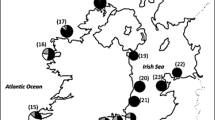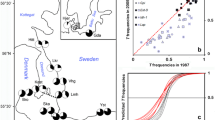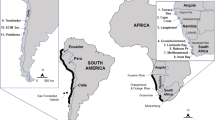Abstract
Marine communities are experiencing unprecedented rates of species homogenization due to the increasing success of invasive species, but little is known about the mechanisms that allow a species to invade and persist in a new habitat. In central California, native (Mytilus trossulus Gould 1850) and invasive (Mytilus galloprovincialis Lamarck 1819) blue mussels and their hybrids co-exist, providing an opportunity to analyze the mechanisms that determine the distributions of these taxa. Spatial and temporal variation in temperature and salinity and the relative frequencies of these mussel taxa were examined between 2000 and 2004 at four sites in San Francisco Bay and four in Monterey Bay, which were chosen for their different positions along inferred estuarine/oceanic gradients in the hybrid zone. Mussels were genetically identified as the parent species or hybrids by amplifying regions of two species-specific loci: the adhesive byssal thread protein (Glu-5′) and the internal transcribed spacer region of ribosomal DNA (ITS 1). The proportion of M. trossulus at the eight hybrid zone sites correlated negatively with average salinity (R 2=0.60) and positively with maximal temperature (R 2≥0.72), a somewhat unexpected result given what is known about the phylogeography of this species. The proportion of M. galloprovincialis showed the opposite pattern. The proportion of hybrids was correlated neither with habitat temperature nor salinity. Genotypes of mussel populations at an additional 13 sites from Coos Bay, Oregon (latitude 43.35°N) to Long Beach, California (latitude 33.72°N), sampled at various intervals between 2000 and 2004, were also determined. This survey confirmed previous reports that the hybrid zone lies between Monterey and the Cape Mendocino region (latitudes 36.63°N–40.5°N). Within Monterey and San Francisco Bays, however, the temporal comparisons (1990s vs. 2000s) revealed abrupt changes in the proportions of the two parent species and their hybrids on annual and decadal time scales. These changes indicate that the blue mussel populations are in a highly dynamic state. The survey also showed that, regardless of habitat, M. trossulus is consistently of smaller average size than either M. galloprovincialis or hybrids.






Similar content being viewed by others
Notes
The term “invasive species” is used throughout this paper to mean a species that was transported by humans to a new location where it did not previously occur, and which has spread from its initial site of introduction to other sites, where it produces viable offspring (based on definition by Richardson et al. 2000).
References
Anderson AS, Bilodeau AL, Gilg MR, Hilbish TJ (2002) Routes of introduction of the Mediterranean mussel (Mytilus galloprovincialis) to Puget Sound and Hood Canal. J Shellfish Res 21:75–79
Barsotti G, Meluzzi C (1968) Osservazioni su Mytilus edulis L. e Mytilus galloprovincialis Lam. Conchiglie 4:50–58
Bierne N, David P, Boudry P, Bonhomme F (2002a) Assortative fertilization and selection at larval stage in the mussels Mytilus edulis and M. galloprovincialis. Evolution 56:292–298
Bierne N, David P, Langlade A, Bonhomme F (2002b) Can habitat specialisation maintain a mosaic hybrid zone in marine bivalves? Mar Ecol Prog Ser 245:157–170
Bierne N, Bonhomme F, David P (2003a) Habitat preference and the marine-speciation paradox. Proc R Soc Lond B Biol Sci 270:1399–1406
Bierne N, Borsa P, Daguin C, Jollivet D, Viard F, Bonhomme F, David P (2003b) Introgression patterns in the mosaic hybrid zone between Mytilus edulis and M. galloprovincialis. Mol Ecol 12:447–461
Bierne N, Daguin C, Bonhomme F, David P, Borsa P (2003c) Direct selection on allozymes is not required to explain heterogeneity among marker loci across a Mytilus hybrid zone. Mol Ecol 12:2505–2510
Boecklen WJ, Howard DJ (1997) Genetic analysis of hybrid zones: numbers of markers and power of resolution. Ecology 78(8):2611–2616
Braby CE (2004) Physiological ecology of native and invasive blue mussels (Genus Mytilus) in Central California. PhD Dissertation, Stanford University
Comesaña AS, Toro JE, Innes DJ, Thompson RJ (1999) A molecular approach to the ecology of a mussel (Mytilus edulis–M. trossulus) hybrid zone on the east coast of Newfoundland, Canada. Mar Biol 133: 213–221
Comesaña AS, Sanjuan A (1997) Microgeographic allozyme differentiation in the hybrid zone of Mytilus galloprovincialis Lmk. and M. edulis L. on the continental European coast. Helgol Meeresunters 51: 107–124
Connolly SR, Menge BA, Roughgarden J (2001) A latitudinal gradient in recruitment of intertidal invertebrates in the northeast Pacific Ocean. Ecology 82:1799–1813
Danner EM (1999) The effects of recruitment and predation of an inferior competitor in the rocky intertidal. Masters of Science. Department of Biology, University of California Santa, 34 pp
Gardner JPA (1994) The structure and dynamics of naturally-occurring hybrid Mytilus edulis Linnaeus, 1758 and Mytilus galloprovincialis Lamarck, 1819 (Bivalvia, Mollusca) populations: Review and interpretation. Arch Hydrobiol 99:37–71
Gardner JPA, Thompson RJ (2001) The effects of coastal and estuarine conditions on the physiology and survivorship of the mussels Mytilus edulis, M. trossulus and their hybrids. J Exp Mar Biol Ecol 265: 119–140
Geller JB (1999) Decline of a native mussel masked by sibling species invasion. Conserv Biol 13:661–664
Gilg MR, Hilbish TJ (2000) The relationship between allele frequency and tidal height in a mussel hybrid zone: a test of the differential settlement hypothesis. Mar Biol 137:371–378
Gilg MR, Hilbish TJ (2003a) Spatio-temporal patterns in the genetic structure of recently settled blue mussels (Mytilus spp.) across a hybrid zone. Mar Biol 143:679–690
Gilg MR, Hilbish TJ (2003b) The geography of marine larval dispersal: coupling genetics with fine-scale physical oceanography. Ecology 84:2989–2998
Gilg MR, Hilbish TJ (2003c) Patterns of larval dispersal and their effect on the maintenance of a blue mussel hybrid zone in southwestern England. Evolution 57:1061–1077
Gosling E (1991) Genetics of Mytilus. In: Gosling E (eds) The mussel Mytilus: ecology, physiology, genetics and culture. Elsevier, New York pp 309–382
Harrison RG, Rand DM (1989) Mosaic hybrid zones and the nature of species boundaries. In: Otte D, Endler JA (eds) Speciation and its consequences. Sinauer Associates, Inc., Sunderland pp 111–133
Heath DD, Rawson PD, Hilbish TJ (1995) PCR-based nuclear markers identify alien blue mussel (Mytilus spp.) genotypes on the west coast of Canada. Can J Fish Aquat Sci 52:2621–2627
Hilbish TJ, Carson EW, Plante JR, Weaver LA, Gilg MR (2002) Distribution of Mytilus edulis, M. galloprovincialis, and their hybrids in open-coast populations of mussels in southwestern England. Mar Biol 140:137–142
Hilbish TJ, Timmons J, Agrawal V, Schneider KR, Gilg MR (2003) Estuarine habitats protect hybrid mussels from selection. J Exp Mar Biol Ecol 292:177–186
Hoss M, Paabo V (1993) DNA extraction from Pleistocene bones by a silica-based purification method. Nucleic Acids Res 21:3913–3914
Inoue K, Waite JH, Matsuoka M, Odo S, Harayama S (1995) Interspecific variations in adhesive protein sequences of Mytilus edulis, M. galloprovincialis, and M. trossulus. Biol Bull Mar Bio Lab Woods Hole 189:370–375
Inoue K, Odo S, Noda T, Nakao S, Takeyama S, Yamaha E, Yamazaki F, Harayama S (1997) A possible hybrid zone in the Mytilus edulis complex in Japan revealed by PCR markers. Mar Biol 128:91–95
Maloy A, Barber B, Rawson P (2003) Gametogenesis in a sympatric population of blue mussels, Mytilus edulis and Mytilus trossulus, from Cobscook Bay (USA). J Shellfish Res 22:119–123
McDonald JH, Koehn RK (1988) The mussels Mytilus galloprovincialis and Mytilus trossulus on the Pacific coast of North America. Mar Biol 99:111–118
Menge BA, Olson AM (1990) Role of scale and environmental factors in regulation of community structure. Trends Ecol Evol 5:52–57
Rawson PD, Joyner KL, Meetze K, Hilbish TJ (1996a) Evidence for intragenic recombination within a novel genetic-marker that distinguishes mussels in the Mytilus edulis species complex. Heredity 77:599–607
Rawson PD, Secor CL, Hilbish TJ (1996b) The effects of natural hybridization on the regulation of doubly uniparental mtDNA inheritance in blue mussels (Mytilus spp.). Genetics 144: 241–248
Rawson PD, Agrawal V, Hilbish TJ (1999) Hybridization between the blue mussels Mytilus galloprovincialis and M. trossulus along the Pacific coast of North America: evidence for limited introgression. Mar Biol 134:201–211
Rawson PD, Slaughter C, Yund PO (2003) Patterns of gamete incompatibility between the blue mussels Mytilus edulis and M. trossulus. Mar Biol 143:317–325
Rawson PD, McGowen A, Bartlett C (2004) Temporal variation in the settlement of blue mussels (Mytilus edulis C. Linnaeus, 1758 and M. trossulus Gould 1850) in eastern Maine. J Shellfish Res 23:521–528
Rawson PD, Hilbish TJ (1995) Distribution of male and female mtDNA lineages in populations of blue mussels, Mytilus trossulus and M. galloprovincialis, along the Pacific coast of North America. Mar Biol 124:245–250
Richardson DM, Pysek P, Rejmanek M, Barbour MG, Panetta FD, West CJ (2000) Naturalization and invasion of alien plants: concepts and definitions. Divers Distrib 6:93–107
Ricketts EF, Calvin J, Hedgpeth JW (1962) Between pacific tides. Stanford University Press, Stanford
Riginos C, Sukhdeo K, Cunningham CW (2002) Evidence for selection at multiple allozyme loci across a mussel hybrid zone. Mol Biol Evol 19:347–351
Sarver SK, Foltz DW (1993) Genetic population structure of a species’ complex of blue mussels (Mytilus spp.). Mar Biol 117:105–112
Seed R (1992) Systematics evolution and distribution of mussels belonging to the genus Mytilus: an overview. Am Malacol Bull 9:123–137
Seed R, Suchanek TH (1991) Population and community ecology of Mytilus. In: Gosling E (eds) The mussel Mytilus: ecology, physiology, genetics and culture. Elsevier, New York pp 87–169
Suchanek TH (1978) Ecology of Mytilus edulis L. in exposed rocky intertidal communities. J Exp Mar Biol Ecol 31:105–120
Suchanek TH, Geller JB, Kreiser BR, Mitton JB (1997) Zoogeographic distributions of the sibling species Mytilus galloprovincialis and M. trossulus (Bivalvia: Mytilidae) and their hybrids in the North Pacific. Biol Bull Mar Bio Lab, Woods Hole 193:187–194
Swofford DL, Selander RB (1981) BIOSYS-1: a FORTRAN program for comprehensive analysis of electrophoretic data in population genetics and systematics. J Hered 72:281–283
Toro JE, Thompson RJ, Innes DJ (2002) Reproductive isolation and reproductive output in two sympatric mussel species (Mytilus edulis, M. trossulus) and their hybrids from Newfoundland. Mar Biol 141:897–909
Vermeij GJ (1991) Anatomy of an invasion: the trans-Arctic interchange. Paleobiology 17:281–307
Viard F, Delay B, Coustau C, Renaud F (1994) Evolution of the genetic structure of bivalve cohorts at hybridization sites of the Mytilus edulis–M galloprovincialis complex. Mar Biol 119:535–539
Wilhelm R, Hilbish T (1998) Assessment of natural selection in a hybrid population of mussels: evaluation of exogenous vs. endogenous selection models. Mar Biol 131:505–514
Wonham MJ (2004) Mini-review: distribution of the Mediterranean mussel Mytilus galloprovincialis (Bivalvia: Mytilidae) and hybrids in the Northeast Pacific. J Shellfish Res 23:535–543
Zhuang QQ (1992) Research on marine bivalves in the Peoples-Republic-of-China. Am Malacol Bull 9:207–215
Acknowledgements
This research was supported by (1) the National Sea Grant College Program of the U.S. Department of Commerce’s National Oceanic and Atmospheric Administration under NOAA Grant no. NA06RG0142, project no. RC/Z-179, through the California Sea Grant College Program, and in part by the California State Resources Agency; (2) the Partnership for Interdisciplinary Study of Coastal Oceans (PISCO)(this is PISCO publication #196), (3) National Science Foundation grant IBN-0133184, and (4) the Earl and Ethel Myers Marine Biological and Oceanographic Trust. This work benefited from the aid of many especially including J.P. Lopez, M. Chaney, M. Phillips, Dr. G. Hofmann, Dr. A. Whitmer, and C. Rerig. The experiments contained herein comply with the current laws of the United States, in which they were performed.
Author information
Authors and Affiliations
Corresponding author
Additional information
Communicated by J.P. Grassle, New Brunswick
Rights and permissions
About this article
Cite this article
Braby, C.E., Somero, G.N. Ecological gradients and relative abundance of native (Mytilus trossulus) and invasive (Mytilus galloprovincialis) blue mussels in the California hybrid zone. Marine Biology 148, 1249–1262 (2006). https://doi.org/10.1007/s00227-005-0177-0
Received:
Accepted:
Published:
Issue Date:
DOI: https://doi.org/10.1007/s00227-005-0177-0




